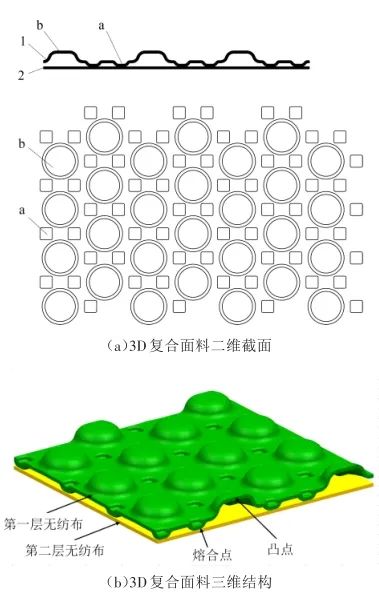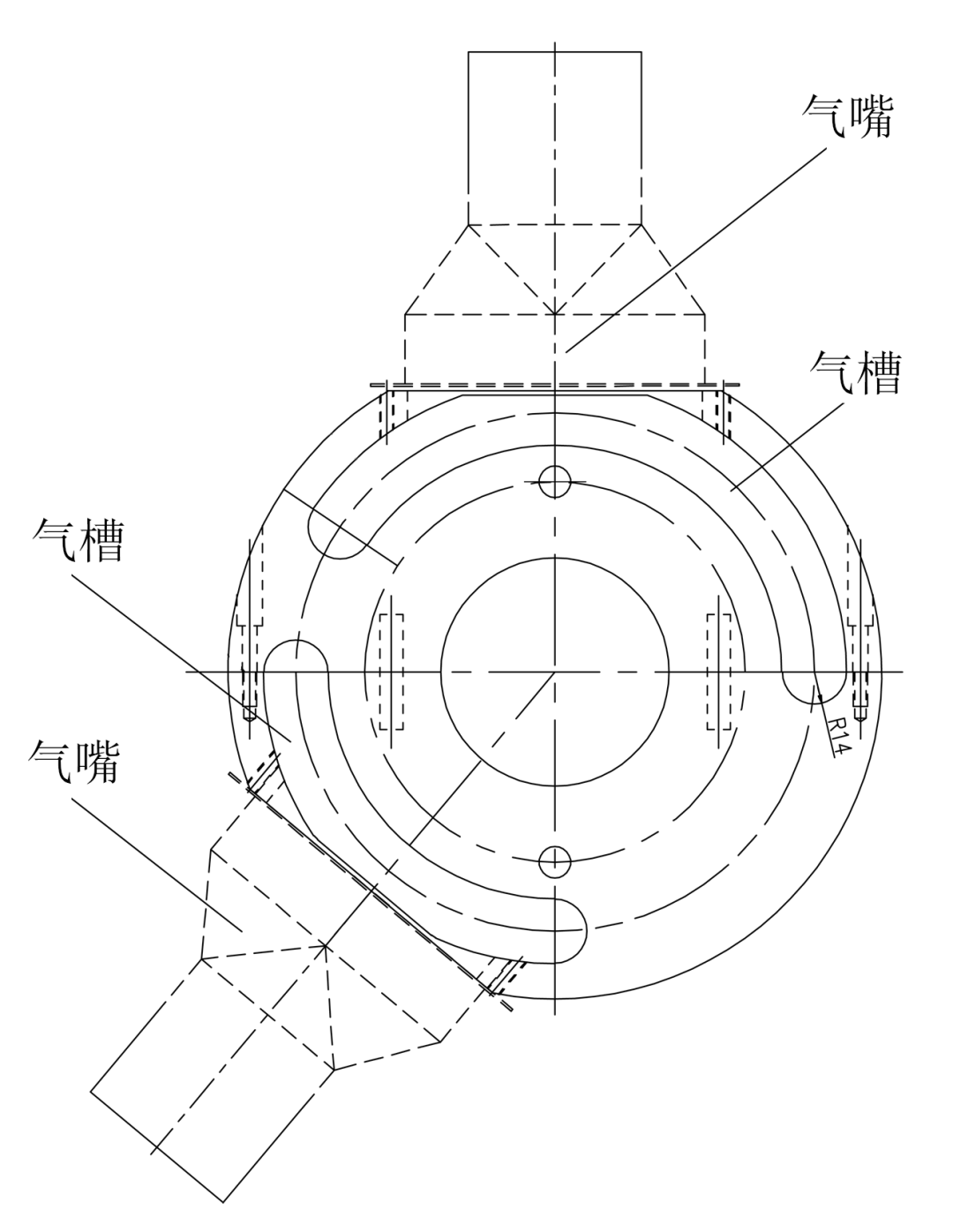Abstract 3D composite fabric is a new type of absorbent composite fabric. Its forming equipment is a composite concave and convex embossed roller mold that integrates shaping, shaping, adsorption and transmission and various transmissions. , the design difficulty is to adapt to various raw material thicknesses, peeling force requirements and 3D forming heights, as well as to adapt to the requirements of high-speed production above 300 m/min. By analyzing the forming process and setting process of the fabric, the composite mold is The overall design is discussed, and the forming structure, shaping structure and transmission structure are introduced. This mold solves various difficulties and achieves good results through ingenious structural design and simulation technology.
Keywords 3D composite fabric; absorber; roller mold; forming; shaping
0 Introduction
3D composite fabric is a new type of fabric developed in recent years Absorbent composite fabrics are widely used in maternal and child hygiene products and other industries. Figure 1 shows a skin-contact three-dimensional composite fabric for absorbent articles. The 3D composite fabric is made of two layers of hydrophilic hot air non-woven fabrics bonded by local hot melt. The first layer of non-woven fabric 1 and the The hydrophilicity of the two layers of non-woven fabric 2 increases in sequence. As shown in Figure 1(a), convex points b are arranged in the part other than the fusion point a of the first layer of non-woven fabric. The convex points b and the fusion point a are arranged alternately. [1], forming a 3D composite fabric as shown in Figure 1(b). The key and difficulty in realizing the production of 3D composite fabrics on high-speed production lines is the design and manufacturing of roll forming molds [2]. Online production of 3D composite fabrics has better forming effects, aesthetics and peeling force than offline production [3 ], also reduces production costs. The difficulty lies in how to achieve the formation and shaping of hydrophilic hot-air non-woven fabric bumps during high-speed production, and to achieve the requirement of no delamination during use. The following introduces the structural design of an online roll forming mold for 3D composite fabrics that can solve these difficulties and meet market requirements.

Figure 1 3D composite fabric product
1. The first layer has no Woven fabric 2. Second layer of non-woven fabric; a. Fusion point b. Bump point
1 Process analysis
1.1 Forming process analysis
To achieve the bump forming effect shown in Figure 1, the first layer of fabric must have a certain thickness and ductility, otherwise it will easily break. Practice has proven that the quality of the first layer of hot-air non-woven fabric is generally not less than 23 g/m2, and the drawing depth is generally not more than 1.5 mm. The quality of the second layer of non-woven fabric is preferably above 18 g/m2 [4]. During the forming process, material rebound, thickness and different depth requirements of customers should be fully considered, so the forming structure must consider a structure with adjustable drawing depth.
The forming punch and the concave mold rotate in opposite directions. During the rotation process of inserting the convex teeth into the corresponding position of the concave mold, they cannot contact and interfere with each other, otherwise the convex teeth may break, so it must be simulated during design. The meshing process of the convex and concave molds needs to be simulated at the maximum meshing depth to ensure that the parts will not interfere.
1.2 Analysis of shaping process
Since the raw material is 0.06~0.08 mm thick hot-air non-woven fabric, which is thin and soft, it is difficult to form after forming if it cannot be bonded with glue. Shaping and shaping the structure are very important. In addition to reducing reverse osmosis, the second layer of non-woven fabric shown in Figure 1 also has two functions through the melting points around the bumps: ① Fusion of the two layers of non-woven fabric into one; ② Shaping the bumps. When designing the shape, it is also necessary to consider that the bumps cannot deform during the transfer process from the forming position to the shaping position, so the shaping structure needs to consider two aspects: melting and transfer shaping.
1.3 Requirements for relative phase fixation between the concave roller and the convex roller
During use, the user will replace the raw materials as needed or the material will break during the production process. At this time, the convex roller must be 1. Disengage the concave mold and re-thread the material. The design of the mold structure must ensure that the relative phase of the convex and concave molds remains unchanged. Otherwise, the convex and concave molds will be damaged when recombined.
1.4 Transmission structure analysis
Based on the above analysis, the mold needs to have the functions of forming, setting and conveying at the same time. It is more complicated than the general roller mold, and the diameter of each mold roller is inconsistent. , so the design of the transmission structure must ensure that the linear speed of the same layer of materials is consistent, otherwise poor fit such as wrinkles or delamination will occur.
2 Structural Design
2.1 Forming Structural Design
Figure 2 shows the structure of the mold forming part. The punch assembly 2 is placed above the mold base. The concave mold assembly 1 is placed below the mold base, using a frame-type mold base 3 [5], the pressurizing mechanism 4 (cylinder pressurization) is placed above the mold frame, the adsorption transfer mechanism 5 is arranged on the front and rear sides of the concave mold, and the air suction port An external air pump or Roots pump with suitable power is used to generate negative pressure in the die through the air suction plate and the air duct system designed in the die to form a complete negative pressure system. The first layer of non-woven fabric passes between the convex and concave roller molds. Under the action of pressure, the convex teeth drive the non-woven fabric into the concave mold. The convex and concave rollers and the formed non-woven fabric move at the same linear speed. Rotation, when the convex teeth leave the female mold, the formed non-woven fabric is tightly fixed in the female mold due to the negative pressure of the female mold and rotates with it until it enters the shaping station of the mold.


Figure 2 �The material forming roller mold is shown in Figure 9. The female mold assembly 1 is fixed in the middle of the mold frame, the remaining three mold rollers surround the circumference of the female mold, and the male mold assembly 2 is on the right side of the female mold assembly. There are two anvil rollers on the upper and lower sides respectively. The punch assembly can move up and down along the slide. The punch is fixed on the inclined block 6 through the pressure of the cylinder pressurizing mechanism 4. The punch can be adjusted at will through the inclined block. The protruding teeth are inserted into the concave mold to the depth to obtain the best forming effect. The anvil roller assembly 7 can slide on the slide, and is pressurized by the cylinder pressure mechanism 4 to tightly press the anvil roller assembly 7 on the surface of the concave mold. In the heated state, it interacts with the convex points on the surface of the concave mold to make the two layers of non-woven fabric The cloth is melted and bonded, while ensuring that the formed bulge does not deform.
Overall structure of the mold
1. Female mold assembly 2. Punch mold assembly 3. Mold base 4. Pressurization Mechanism 6. Inclining block 7. Anvil roller assembly
3 Mold working principle and process
The working principle of the mold is shown in Figure 10. Mold 2 and concave mold 1 rotate toward each other, and the convex teeth of convex mold 2 drive the first layer of non-woven fabric 3 to mesh with the holes of the corresponding phase in concave mold 1 to form a bulge. During the rotation to the first anvil roller 6, it passes through the negative Press area A to always firmly adsorb the formed bulge in the die, and produce plastic deformation under the action of heat. The second layer of non-woven fabric 4 enters between the first anvil roller 6 and the concave mold 1, and the two layers of non-woven fabric are melted and bonded through pressure and heat, and then pressed again by the second anvil roller 7 to further strengthen the two layers. The degree of bonding of non-woven fabrics, and finally the composite 3D composite fabric 5 is output.
Working principle of the mold
1. Concave mold 2. Punch mold 3. First layer of non-woven fabric 4. Second layer of non-woven fabric 5. 3D composite fabric 6. First anvil roller 7. Second anvil roller A. Negative pressure area






